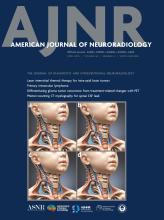This article requires a subscription to view the full text. If you have a subscription you may use the login form below to view the article. Access to this article can also be purchased.
Abstract
BACKGROUND AND PURPOSE: Measurement of the mean upper cervical cord area (MUCCA) is an important biomarker in the study of neurodegeneration. However, dedicated high-resolution (HR) scans of the cervical spinal cord are rare in standard-of-care imaging due to timing and clinical usability. Most clinical cervical spinal cord imaging is sagittally acquired in 2D with thick slices and anisotropic voxels. As a solution, previous work describes HR T1-weighted brain imaging for measuring the upper cord area, but this is still not common in clinical care.
MATERIALS AND METHODS: We propose using a zero-shot super-resolution technique, synthetic multi-orientation resolution enhancement (SMORE), already validated in the brain, to enhance the resolution of 2D-acquired scans for upper cord area calculations. To incorporate super-resolution in spinal cord analysis, we validate SMORE against HR research imaging and in a real-world longitudinal data analysis.
RESULTS: Super-resolved (SR) images reconstructed by using SMORE showed significantly greater similarity to the ground truth than low-resolution (LR) images across all tested resolutions (P < .001 for all resolutions in peak signal-to-noise ratio [PSNR] and mean structural similarity [MSSIM]). MUCCA results from SR scans demonstrate excellent correlation with HR scans (r > 0.973 for all resolutions) compared with LR scans. Additionally, SR scans are consistent between resolutions (r > 0.969), an essential factor in longitudinal analysis. Compared with clinical outcomes such as walking speed or disease severity, MUCCA values from LR scans have significantly lower correlations than those from HR scans. SR results have no significant difference. In a longitudinal real-world data set, we show that these SR volumes can be used in conjunction with T1-weighted brain scans to show a significant rate of atrophy (−0.790, P = .020 versus −0.438, P = .301 with LR).
CONCLUSIONS: Super-resolution is a valuable tool for enabling large-scale studies of cord atrophy, as LR images acquired in clinical practice are common and available.
ABBREVIATIONS:
- 9HPT
- 9-hole peg test
- CSC
- cervical spinal cord
- EDSS
- Expanded Disability Status Scale
- HR
- high-resolution
- LR
- low-resolution
- MSFC
- MS functional composite
- MSSIM
- mean structural similarity
- MUCCA
- mean upper cervical cord area
- PMJ
- pontomedullary junction
- PSNR
- peak signal-to-noise ratio
- SMORE
- synthetic multi-orientation resolution enhancement
- SR
- super-resolved
- T25FW
- timed 25-foot walk
- © 2025 by American Journal of Neuroradiology












